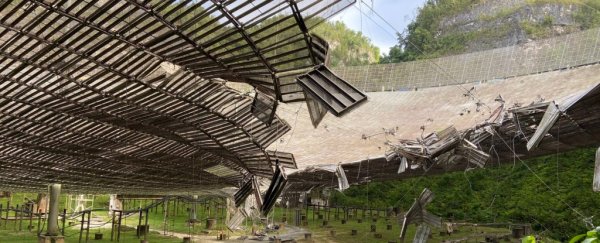One of the world's most prominent astronomical observatories has a hole.
On Monday, a 3-inch-thick (76-mm-thick) cable at the Arecibo Observatory broke, tearing a gash 100 feet (30 metres) long in the reflector dish of the 20-acre radio telescope in Puerto Rico.
The observatory had just reopened after a temporary closure due to Tropical Storm Isaias when the cable, which helped support a metal platform, snapped at about 2:45 am ET.
Now the facility is closed again as engineers assess the damage, according to the University of Central Florida, a co-operator of the telescope.
It was not immediately clear how the cable broke or whether the damage was related to Isaias.
Astronomers use the telescope to study hazardous asteroids as they fly past Earth, in hopes of identifying space rocks on a collision course early enough to intervene before they strike.
Scientists have also used Arecibo to search for signs of intelligent extraterrestrial life. In 1974, Arecibo beamed out the most powerful broadcast Earth has ever sent to communicate with potential aliens.
 The broken cable. (Arecibo Observatory)
The broken cable. (Arecibo Observatory)
Then in 2016, the telescope detected the first repeating fast radio bursts – mysterious space signals of unknown origin.
The cable's fall also damaged six to eight panels in the telescope's Gregorian Dome: the part that focuses its radiation to the points in space that astronomers want to study. It twisted the platform used to access the dome as well.
"We have a team of experts assessing the situation," Francisco Cordova, the director of the observatory, said in a statement.
"Our focus is assuring the safety of our staff, protecting the facilities and equipment, and restoring the facility to full operations as soon as possible, so it can continue to assist scientists around the world."
Tropical Storm Isaias passed over Puerto Rico on July 30, before it developed into a hurricane, leading observatory operators to shutter the facility for a few days.
They turned it back on earlier this month to study a potentially dangerous asteroid the size of five football fields, which was passing Earth at an optimal distance for the observatory to check it out.
NASA had previously calculated a 1 in 70,000 chance that the space rock could impact our planet between 2086 and 2101, so astronomers wanted to track it more closely to better calculate the odds of an impact.
But when a team at Arecibo trained the telescope at the asteroid to determine its shape and orbit, they discovered that it likely won't pass close enough to Earth to pose a threat in the future.
During those observations, the telescope was functioning well.
"Fortunately, the storm passed quickly without damage to the telescope or the radar system, and the maintenance and electronics teams were able to activate the telescope from hurricane lockdown in time for the observations," Sean Marshall, an observatory scientist who led the team doing those radar observations, said at the time.
This article was originally published by Business Insider.
More from Business Insider:
